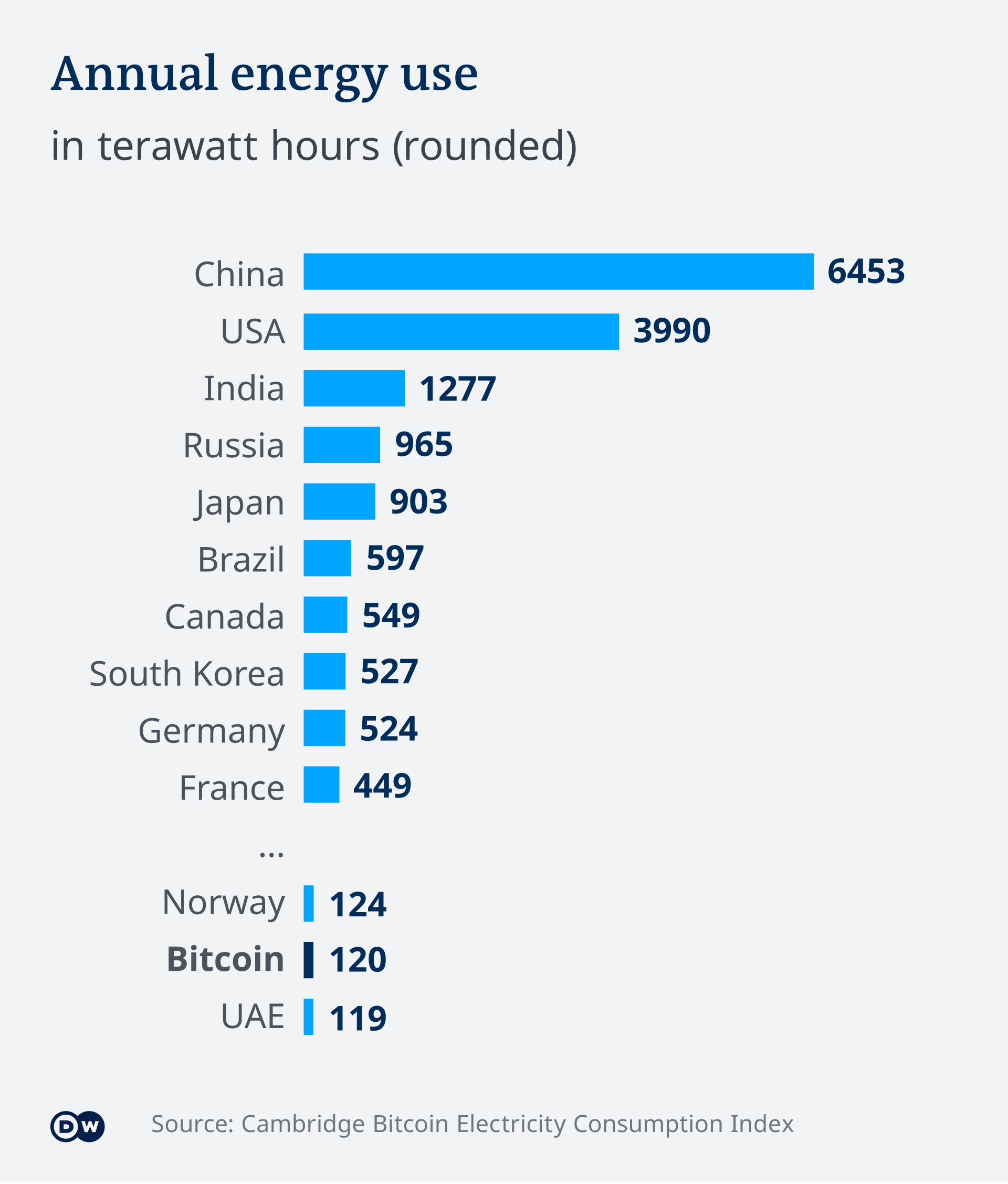Crypto uses a significant amount of energy because miners race against each other to solve equations and earn cryptocurrency, requiring bigger and faster computers that use more energy. This is why Bitcoin, the only major currency that uses proof-of-work mining, has become notorious for its energy consumption levels.
According to Forbes, Bitcoin requires an immense amount of energy due to the fundamental nature of its algorithms. As a result, proof-of-work cryptocurrency mining has not been welcomed in every corner of the world and has been criticized for its environmental impact.
While some argue for a transition to proof-of-stake or pre-mining, others suggest that regulation and taxation of carbon emissions might be necessary to address this energy consumption problem.
The Energy Problem In Crypto
Crypto mining involves solving complex mathematical equations to verify transactions and add them to the blockchain, which requires significant amounts of energy. The high energy cost of bitcoin mining is due to the proof-of-work algorithm used in the process. Miners compete to solve the equation faster, leading to a race towards ever bigger and faster computers that consume more energy.
The consumption of energy by cryptocurrencies, particularly bitcoin, is becoming a global concern. In fact, bitcoin uses more electricity than many countries. Additionally, the energy consumption problem associated with bitcoin mining is an inevitable consequence of its algorithms and may not be resolved anytime soon. This has led to growing calls for eco-friendly ways to power crypto mining and other alternatives like the transition to proof-of-stake mining.
While the high energy costs are a challenge for the crypto industry, it is crucial that the problem is addressed sooner rather than later. It is important to develop sustainable ways to power crypto mining, while also considering the wider environmental impact of blockchain technology.

The Nature Of Proof-of-work Mining
Proof-of-work mining is the only major currency that uses a large amount of energy, which is an inevitable consequence of its algorithms. Due to the demand for electricity, it has not been welcomed everywhere in the world. Miners use a considerable amount of energy to be the first one to solve equations and earn a bitcoin.
Bitcoin and other cryptocurrencies use a large amount of energy for mining due to their proof-of-work (PoW) algorithms. PoW mining involves solving complex mathematical equations to verify transactions and add them to the blockchain. Miners race against each other to solve these equations faster, so they need bigger and faster computers that consume more energy. Bitcoin’s PoW algorithm is designed to be difficult and energy-intensive to prevent fraud and ensure security. While there have been discussions about transitioning to a more eco-friendly proof-of-stake (PoS) system, PoW remains the most widely used mechanism for mining cryptocurrencies. Therefore, crypto mining will continue to consume a significant amount of energy, but efforts to improve energy efficiency within the industry are being made.
Environmental Concerns And Possible Solutions
Crypto uses a large amount of energy due to the proof-of-work mining algorithm used to earn cryptocurrency. Miners compete to solve equations faster and utilize faster computers that consume more energy. The high energy consumption of crypto mining has raised concerns about sustainability and eco-friendliness.
Cryptocurrency mining, especially Bitcoin mining, requires an enormous amount of energy, which has raised environmental concerns. Miners need to race against each other to solve the equations that can earn them a bitcoin, which involves the use of large and fast computers that consume a lot of energy. However, there are possible solutions to mitigate the energy consumption problem. Transitioning to proof-of-stake algorithms from the current proof-of-work system is one such solution. Embracing pre-mining is another eco-friendly solution. Governments can regulate and tax carbon emissions to restrict energy use further. As of now, Bitcoin is the only major currency that uses proof-of-work mining, and this is an inevitable consequence of the fundamental nature of its algorithms.

Measuring Energy Consumption In Crypto
Measuring energy consumption in crypto is important in understanding why the process uses so much energy. Mining for cryptocurrency is an energy-intensive activity due to the nature of its algorithms which require massive computing power. It is important to explore eco-friendly power sources to reduce the carbon footprint of crypto mining.
| Measuring Energy Consumption in Crypto |
| Bitcoin and other cryptocurrencies require a significant amount of energy to run. Many factors such as mining, transactions, and security protocols contribute to this high energy usage. According to reports, Bitcoin mining operations consume nearly 121 terawatt-hours per year, making it one of the largest energy consumers worldwide. With crypto’s rising popularity, tracking the electricity consumption used to power US cryptocurrency mining operations has become essential. Moreover, the carbon footprint of Bitcoin mining is alarming as it is estimated to emit nearly 49 million metric tons of CO2 annually. This is equivalent to the emissions from 10 million cars in a year. The transition to the proof-of-stake algorithm and embracing pre-mining can be effective solutions to reduce this energy consumption. |
| How Much Energy Does Bitcoin Consume? |
| Bitcoin mining requires a massive amount of energy as miners race to be the first one to solve the equation that earns them a bitcoin. They use faster and more powerful computers that require more energy, and this has resulted in high energy consumption. According to crypto.com, bitcoin consumes about 113.89 TWh per year, which is equivalent to the energy consumed in the entire country of Chile. The energy consumption of Bitcoin is also higher than that of traditional banks. It is essential to regulate and control carbon emissions and promote the usage of renewable energy to offset the carbon footprint created from crypto mining. |
| Estimates of Electricity Use and Carbon Footprint of Bitcoin Mining |
| Crypto mining requires a significant amount of electricity, and its carbon footprint is alarming. Reports suggest that Bitcoin’s yearly carbon footprint is equivalent to Las Vegas’ yearly emissions. Moreover, the electricity consumption for mining per transaction is higher than that consumed by an average US household in a month. While Bitcoin mining is energy-intensive, digital currency’s popularity is increasing despite the high energy consumption. Therefore, transitioning to alternative energy sources is crucial for a sustainable future. |
| Digital Dollars and Sense |
| Cryptocurrency’s high energy consumption has become a significant concern for environmentalists and regulators. While the high energy consumption of mining, transactions, and security protocols is an inevitable consequence of crypto’s fundamental nature, there is a need for eco-friendly ways to power crypto. The transition to energy-efficient algorithms like proof-of-stake and reducing the reliance on non-renewable energy sources can reduce crypto’s carbon footprint. Crypto companies must also have a social responsibility to promote the usage of renewable energy sources and offset their carbon footprint. |
Global Impact And Regulation Of Crypto Energy Usage
One of the main reasons why crypto uses so much energy is due to the process of crypto mining. Bitcoin miners use large amounts of energy to race against each other to solve equations that earn them a bitcoin. As they seek bigger and faster computers to solve equations more quickly, it results in increased energy consumption. Bitcoin is the only major currency that uses proof-of-work mining, which is an inevitable consequence of the fundamental nature of its algorithms. Due to its high demand for electricity, proof-of-work cryptocurrency mining has not been welcomed in every corner of the world.
Governments need to regulate and tax carbon emissions to control and reduce their impact on the environment. While Bitcoin isn’t the only villain here, governments can work towards eco-friendly ways of powering crypto. Transitioning to proof-of-stake or embracing pre-mining may also help reduce the energy consumption of mining. As cryptocurrencies become more mainstream, it is essential to find a balance that meets the needs of the economy while minimizing the impact on the environment.
| Resources | Link |
|---|---|
| Why It Takes So Much Energy to Mine Bitcoin | Bloomberg Television |
| The Real Truth About Bitcoin’s Energy Usage | aantonop |
| How Much Energy It Takes to Power Bitcoin | The Balance |
| Tracking Electricity Consumption from U.S. Cryptocurrency Mining Operations | EIA |
| Does Crypto Use More Energy Than Banks? | Cointelegraph |
| Cryptocurrency’s Energy Consumption Problem | RMI |
| Why Does Bitcoin Use So Much Energy? | Forbes |
| Why Does Bitcoin Mining Use Energy? | River Financial |

Frequently Asked Questions For Why Does Crypto Use So Much Energy
Why Does Crypto Mining Cost So Much Energy?
Crypto mining consumes a lot of energy because miners compete to solve equations to earn bitcoins. They use bigger and faster computers, which require more energy. Bitcoin’s proof-of-work algorithm is the main reason for its high energy consumption.
How Much Energy Does It Take To Make Cryptocurrency?
Crypto mining takes a lot of energy due to proof-of-work algorithms. Miners race to solve equations to earn crypto, and use large amounts of energy in the process. Bitcoin uses the most energy among cryptocurrencies. Proof-of-stake and pre-mining could be alternatives to reduce energy consumption.
Is Crypto Energy Intensive?
Yes, crypto is energy intensive especially in terms of Bitcoin mining. Miners need to use large amounts of energy in order to solve mathematical equations that earn them Bitcoin. With each attempt, miners seek out bigger and faster computers that consume more energy.
As a result, the large energy usage associated with proof-of-work mining is an inevitable consequence of the fundamental nature of its algorithms.
Does Crypto Use More Energy Than Banks?
Mining cryptocurrencies like Bitcoin requires significant energy consumption due to its proof-of-work mining algorithm, which involves solving complex mathematical equations. Miners compete to solve these equations faster, using more energy with larger and faster computers. This energy consumption makes it more significant than traditional banking systems.
Conclusion
The energy consumption involved in crypto mining is a complex issue, with both pros and cons. On one hand, it ensures the security and stability of the currency, while on the other hand, it contributes significantly to the carbon footprint and global climate change.
However, with the increasing awareness of renewable energy sources, the use of sustainable energy in crypto mining can drastically reduce its negative impact on the environment. It is up to the crypto industry and its stakeholders to find a balance between energy consumption and environmental responsibility.

